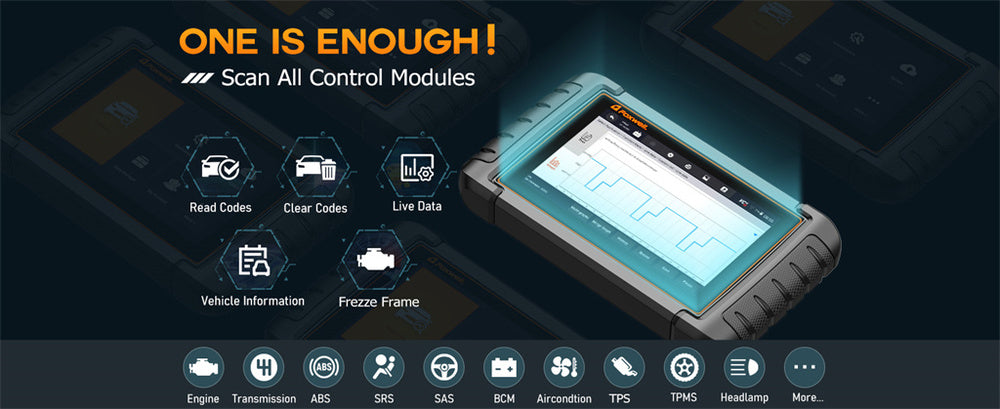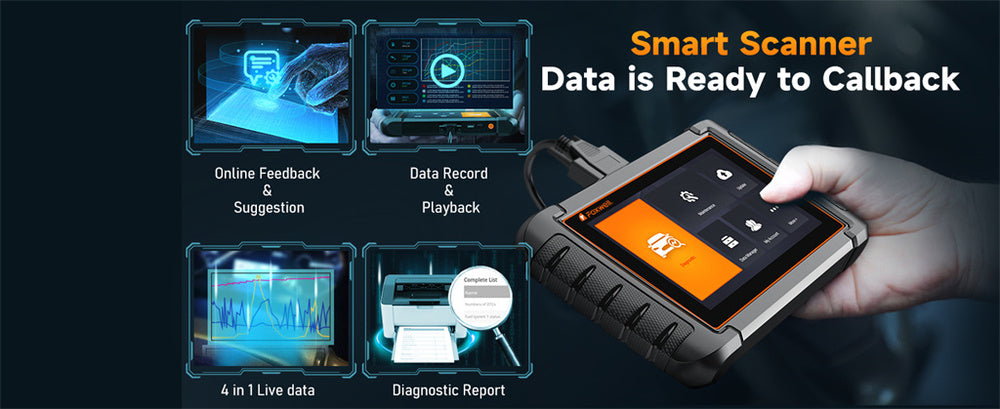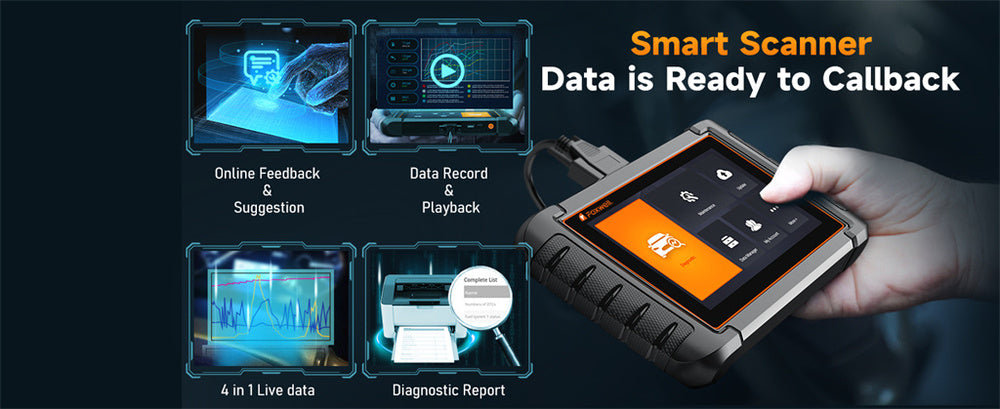For Ford vehicle owners, keeping your car running smoothly and addressing potential issues can be tough without the right tools. Luckily, On-Board Diagnostics II (OBD2) scanners have changed the game, giving you a DIY approach to take control of your vehicle's health. This blog will explore how OBD2 scanners work, their benefits, how Ford-specific scanners differ from generic models, how to use them effectively, and practical tips for keeping these tools in top shape.
Benefits of Using OBD2 Scanners for Ford Owners

Proactive Problem Detection
One of the main perks of OBD2 scanners is their ability to catch problems early. By reading diagnostic trouble codes (DTCs), Ford owners can spot potential issues before they turn into expensive repairs.
Cost Savings
Using an OBD2 scanner can save you a lot of money on repairs. Instead of always relying on mechanics for diagnostics, you can do initial checks yourself, cutting down on unnecessary service visits.
Enhanced Performance Monitoring
OBD2 scanners give you real-time data on various performance metrics, letting you continuously monitor your vehicle’s health. This ongoing check helps ensure your car runs efficiently and stays in top shape.
DIY Repairs and Maintenance
With an OBD2 scanner, Ford owners can handle minor repairs and routine maintenance tasks on their own. This empowerment reduces the need for professional services for every little issue, promoting a more hands-on approach to vehicle care.
Increased Knowledge and Confidence
Using an OBD2 scanner educates Ford owners about their vehicle’s inner workings. This knowledge not only boosts your confidence in handling car issues but also leads to better decisions regarding maintenance and repairs.
How OBD2 Scanners for Ford Differ from Other Models
When it comes to diagnosing and maintaining vehicles, not all OBD2 scanners are the same. Ford vehicles have specific needs and features that generic OBD2 scanners might not fully address. Understanding these differences can help you pick the best scanner for your Ford.
Manufacturer-Specific Codes
While all OBD2 scanners can read generic trouble codes (DTCs) that apply to all vehicles, Ford-specific scanners can read manufacturer-specific codes. These codes give more detailed info about issues unique to Ford, Lincoln, and Mercury vehicles, enabling more accurate diagnostics and repairs.
Advanced Diagnostics and Programming
Ford-specific OBD2 scanners, like FORScan, offer advanced diagnostic capabilities beyond basic code reading. These scanners can perform functions such as module programming, bi-directional tests, and access to Ford-specific systems like the Body Control Module (BCM) and Powertrain Control Module (PCM).
Access to Enhanced Data
Generic OBD2 scanners might not access all the data points available in Ford vehicles. Ford-specific scanners provide enhanced data logging and live data streaming from various systems, giving a more complete picture of your vehicle’s health and performance.
Compatibility with Ford’s Proprietary Systems
Ford vehicles may have proprietary systems and features not present in other brands. Scanners designed for Ford can communicate effectively with these systems, ensuring accurate readings and effective diagnostics. This includes access to features like PATS (Passive Anti-Theft System) programming and key programming.
Tailored User Interface
Scanners designed for Ford often feature a user interface tailored to the brand’s specific needs and common issues. This makes it easier for users to navigate the diagnostic process, understand results, and perform necessary functions.
How to Use an OBD2 Scanner on Your Ford
Using an OBD2 scanner on your Ford vehicle is pretty straightforward. Let's take the Foxwell NT726 as an example, a popular model that supports a wide range of Ford vehicles.
- Locate the OBD2 Port: The OBD2 port is usually under the dashboard on the driver’s side. In most Ford models, it’s easy to find near the steering column.
- Connect the Scanner: Plug the Foxwell NT726 (or your chosen OBD2 scanner) into the OBD2 port. Make sure it’s securely connected.
- Power On the Ignition: Turn on your vehicle without starting the engine. This action powers the onboard systems and the scanner.
- Select Vehicle Make and Model: Use the scanner’s menu to select your vehicle’s make and model. For the Foxwell NT726, navigate through the user-friendly interface to find Ford, then your specific model.
- Read Diagnostic Codes: Follow the scanner’s instructions to read the diagnostic trouble codes (DTCs). The Foxwell NT726 will display the codes along with descriptions, making it easier to understand potential issues.
- Interpret the Codes: Use the scanner’s manual or online resources to interpret the codes. Foxwell provides detailed explanations and troubleshooting tips for each code.
- Clear Codes: After addressing any issues, you can clear the codes using the scanner to reset the system. This step ensures the warning lights are turned off and the system is ready for fresh monitoring.

How to Maintain Your OBD2 Scanner
Proper maintenance of your OBD2 scanner ensures it stays reliable and works correctly over time. Here are some tips to keep your scanner in top condition:
Regular Cleaning
Dust and dirt can build up on the scanner and its connectors, potentially affecting performance. Clean the scanner’s exterior and connectors regularly using a soft, dry cloth. Avoid using harsh chemicals or water.
Proper Storage
Store your OBD2 scanner in a cool, dry place when not in use. Avoid leaving it in the car, especially in extreme temperatures, as this can damage the electronic components.
Software Updates
Many OBD2 scanners come with software that can be updated. Regularly check for and install updates to ensure your scanner has the latest features and compatibility improvements. Follow the manufacturer's instructions for updating the software.
Handle with Care
Treat your OBD2 scanner with care. Avoid dropping it or subjecting it to physical shocks. Rough handling can damage the internal components and affect its functionality.
Check for Firmware Updates
Some advanced OBD2 scanners have firmware that can be updated to enhance performance and fix bugs. Check the manufacturer’s website periodically for firmware updates and follow the instructions to install them.
Use Compatible Accessories
Only use cables and accessories that are compatible with your OBD2 scanner. Using incorrect or substandard accessories can cause damage or unreliable performance.
Avoid Prolonged Exposure
Do not leave the scanner connected to the vehicle for extended periods when not in use. Prolonged exposure can drain the vehicle’s battery and potentially cause wear on the scanner’s connectors.
Inspect Cables and Connectors
Regularly inspect the scanner’s cables and connectors for signs of wear or damage. Replace any damaged components immediately to avoid performance issues or potential short circuits.
Conclusion
An OBD2 scanner is a powerful tool that empowers Ford owners to take charge of their vehicle’s health. By enabling proactive problem detection, cost-effective maintenance, enhanced performance monitoring, and DIY repairs, OBD2 scanners are indispensable for modern car care. Understanding the unique benefits of Ford-specific scanners, using them effectively, and maintaining them properly ensures your Ford runs smoothly and efficiently, providing peace of mind and a deeper connection with your vehicle.
FAQs:
What is an OBD2 scanner?
An OBD2 scanner is a device that reads diagnostic trouble codes from a vehicle's onboard computer.
How does an OBD2 scanner benefit Ford owners?
It helps Ford owners identify and fix issues early, saving time and money on repairs.
Can anyone use an OBD2 scanner?
Yes, most OBD2 scanners are user-friendly and come with instructions, making them accessible to all car owners.




Leave a comment
This site is protected by hCaptcha and the hCaptcha Privacy Policy and Terms of Service apply.